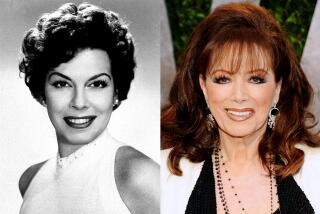An unchoreographed dance with Hollywood
London — In her new memoir, “The Memory of All That: Love and Politics in New York, Hollywood and Paris,” stage and screen actress Betsy Blair describes her chance meeting at age 16 with Gene Kelly -- then a 28-year-old first-time choreographer -- at Billy Rose’s Diamond Horseshoe club in New York City.
This encounter, and how it led to Kelly’s hiring, then marrying, the naively self-assured New Jersey-born hoofer, isn’t new to anyone who’s ever skimmed one of Kelly’s many biographies. What’s different is the direction the anecdote takes: Instead of existing as an early detail in Kelly’s rise to America’s preeminent song-and-dance man, the Diamond Horseshoe story sets up Blair’s parallel view.
While still in her teens, Blair is whisked off to Hollywood by her soon-to-be-megastar husband, where she will raise their only child, daughter Kerry, piece together a midlevel acting career and immerse herself in leftist politics (for which she was blacklisted during the McCarthy-era “Red Scare.”)
What she doesn’t do -- until she gets a quickie Vegas divorce from Kelly in 1957 and flies off to a lover in Paris -- is figure out who she is. In this way, “The Memory of All That” is ultimately the story of a young girl who’s willing to forfeit a great deal to become an adult. This being a show-biz saga, however, Blair first has to show just how great the “great deal” was -- and thereby offers a dazzling Hollywood travelogue.
Her tone -- casual reportage mixed with girlish delight -- makes the book a breezy read. Of some of the gold-star guests who attended the Kellys’ regular Saturday-night get-togethers, Blair writes: “I don’t remember who brought Noel Coward, but there he was.” She then goes on to recount a typical shindig, where, after Judy Garland belts out a few tunes and Kelly improvises a dance number, Coward takes his place behind the grand piano and delivers a greatest-hits recital of his witty, sophisticated songs.
Blair is 79 now, with a gray flyaway pageboy and a voice husky from cigarettes. But spend two hours with her in the cluttered kitchen of her five-story brick house in London’s exclusive Primrose Hill district and it’s easy to imagine her as a bright, energetic ingenue who took in everything that unfolded around her. It’s something to do with the intelligence in her blue eyes and the way she tends to lean her chin on her fist coquettishly when she’s listening. Or maybe it’s how she tells a story: Fixing you with her direct gaze, she blows past the dross and hones in on all the right details.
What’s her memory, for example, of a not-yet-iconic Marilyn Monroe? A breathy starlet who arrived at their house on the arm of director Nicholas Ray and made a beeline for the living room couch. “They were necking the whole evening,” Blair says, tossing her head back and laughing. “I can’t say I saw a great spark. I just thought she was a sweet, pleasant, jazzy girl that Nick was dating at the time. Now, the prettiest one that ever came over was Elizabeth Taylor -- she was just ravishing.”
Trying a novel first
“The Memory of All That” isn’t the first time Blair set out to put her full life on paper. During her frustrating blacklist years, Blair tried filling up long stretches of free time by writing a novel that came to naught.
It wasn’t until Kelly’s death in 1996 that Blair turned to writing fiction again. “It wasn’t, um, very pleasant after Gene died,” says Blair, referring to a rift that began when daughter Kerry Kelly Novick, along with Tim and Bridget Kelly (Kelly’s children from his second marriage, to Jeanne Coyne), went to pay a last visit to their father. Kelly’s final wife, Patricia Ward Kelly -- they married in 1990 when she was 36 and he was 77 -- informed them that their father had been cremated just hours after his passing and that no funeral would take place.
“We weren’t given any opportunity to say goodbye,” says Novick, a psychoanalyst living in Michigan. “My mother knew how sad that was for my brother, sister, me and the grandchildren. She wanted to give us back the whole person of who my father was.”
Blair’s plan was to return Kelly to his brood by penning an entertainingly trashy Hollywood novel. “I thought, ‘Everyone will know who it’s about,’ ” says Blair, who completed 40 pages of a Jackie Collins-style page-turner before good friend John Lahr, a New Yorker theater critic and profile writer, persuaded her to switch to nonfiction.
“She was at the center of the great flourishing of the American film musical at the time it was taking shape,” says Lahr, who lives in the top two floors of Blair’s London home and thinks of her as a surrogate mother. The people she met were “major players in the story of American entertainment. She knew William Saroyan; she walked on the beach with Brecht; she understudied in the first production of ‘Glass Menagerie.’ I mean, who has had that kind of life?”
Occasionally, in “The Memory of All That,” the number of Blair’s encounters with the greats is dizzying. On Page 248, she lunches with a gossipy Stella Adler, then reminisces about afternoon meals she had with George Cukor, Greta Garbo, Katharine Hepburn and Ethel Barrymore. By the following page, she’s hanging around with old pals Simone Signoret and Yves Montand. A wonderful photo of a vivacious Signoret in London on Page 250 leaves only enough space for a paragraph, which Blair use to describe weekends at the Montand country home where she’d find herself playing charades with an elderly, rather deaf Luis Bunuel or sizing up another regular Montand houseguest, Pablo Picasso.
Blair’s feelings about Ward Kelly are still there as well, just relegated to a measured evisceration in the foreword. Was this Lahr’s idea too? “That was all Betsy,” says Lahr. “It’s called smiling with cold teeth.”
As for Ward Kelly, she seems capable of smiling coldly right back. “Oh, gosh. I wish her all the best,” says Ward Kelly, when asked to comment on “The Memory of All That.” “It’s a really tough time in the publishing industry.”
She plans her own book, “Life’s Too Short: A Story of Gene Kelly,” based on extensive interviews she conducted with Kelly. It was to have been published a few months before Blair’s memoir, but it hasn’t yet appeared. (“The author is still working on it,” says a spokesperson for the publishing company, Public Affair Ltd. “It’s not currently scheduled for ’03.”)
When asked how she felt about “The Memory Of All That” hitting bookstores first, Blair says, “I can’t help but be pleased,” then falls silent. A series of emotions ripples across her face -- satisfaction? pride? competitiveness? In lieu of further explanation, Blair gives a glimpse of the dramatic skills that earned her a Academy Award nomination for her role as the plain-Jane date of a lonely butcher in Paddy Chayefsky’s “Marty” (1955). After taking a deep puff off her fourth cigarette, she exhales a thin stream of white smoke. Then, with perfect timing, she raises an eyebrow and grins.
It’s a nice moment, one in which the pre-interview jitters she’d admitted to earlier in the conversation seem to vanish completely. But if Blair’s mood has abrupt shifts, she has good reason. On Nov. 25, her second husband, film director Karel Reisz (“The French Lieutenant’s Woman”), died of a lingering blood disorder, and as we speak not long after, her grief descends and rises unexpectedly.
When asked what Kelly was like as a husband, she starts with, “He was an intellectual, progressive man but a bit of a patriarch, and I was this little angel he found and loved and ....” Suddenly, her voice grows thick and her eyes fill with tears. “Karel said to me just the week before [he died], ‘It’s a good thing that you have the book coming,’ ” says Blair. “And he was right, of course, because I have to get doing things.”
A young talent
For Blair, nee Elizabeth Boger, being idle has never been an option. The third child of insurance broker Willet Boger and his schoolteacher wife, Frederica, Blair was winning talent shows when she was 9. Not long after, she began supplementing the family income as a photographer’s model, then as a professional dancer. The plan after high school was to work as a chorus girl until fall, when she’d take advantage of a scholarship to Sarah Lawrence College. Then, she auditioned for Gene Kelly.
The last formal instruction Blair received on writing was for a “How I Spent My Summer Vacation” essay back in high school. Is that where she learned to be so frank? There’s a quality of unflinching candor in “The Memory of All That” -- particularly in the passages that focus on a string of affairs she had while married to Kelly and the exhilaration that accompanied her betrayal. “No guilt, no consciousness, no ‘What am I doing?’ ” is how she describes her state of mind after her first dalliance, with a young Frenchman she barely knew.
Before Blair finally left Kelly, she got him to confess to his own infidelities. Nevertheless, she somehow is the one who comes off as the more unfaithful.
After all these years, why reveal the unflattering truth when, as many show-biz memoir authors will tell you, a sunnier half-truth would do? “What’s the sense if you don’t?” asks Blair, who wanted “The Memory of All That” to not only tell the truth about a time and a place in Hollywood, but also to have an emotional accuracy. Her honesty extends to how, as the philandering wife of one of America’s most beloved movie stars, she managed to escape the media’s watchful eye.
“It wasn’t me who was the famous one,” Blair says with a little shrug. “Besides, I looked very innocent. I didn’t look like Ava Gardner.”
More to Read
Sign up for our Book Club newsletter
Get the latest news, events and more from the Los Angeles Times Book Club, and help us get L.A. reading and talking.
You may occasionally receive promotional content from the Los Angeles Times.








